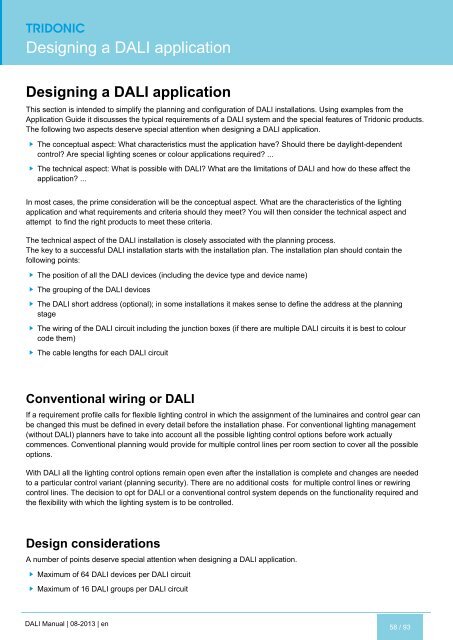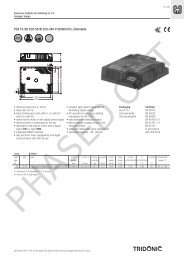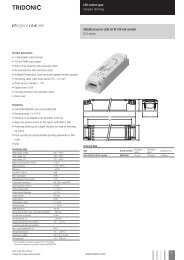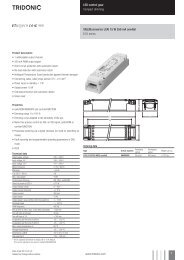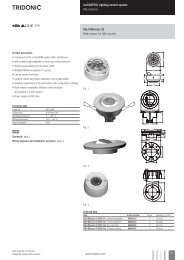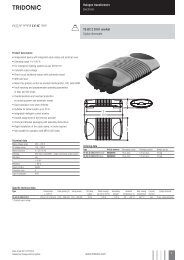DALI manual - Tridonic
DALI manual - Tridonic
DALI manual - Tridonic
You also want an ePaper? Increase the reach of your titles
YUMPU automatically turns print PDFs into web optimized ePapers that Google loves.
.<br />
c<br />
Designing a <strong>DALI</strong> application<br />
Designing a <strong>DALI</strong> application<br />
This section is intended to simplify the planning and configuration of <strong>DALI</strong> installations. Using examples from the<br />
Application Guide it discusses the typical requirements of a <strong>DALI</strong> system and the special features of <strong>Tridonic</strong> products.<br />
The following two aspects deserve special attention when designing a <strong>DALI</strong> application.<br />
The conceptual aspect: What characteristics must the application have? Should there be daylight-dependent<br />
control? Are special lighting scenes or colour applications required? ...<br />
The technical aspect: What is possible with <strong>DALI</strong>? What are the limitations of <strong>DALI</strong> and how do these affect the<br />
application? ...<br />
In most cases, the prime consideration will be the conceptual aspect. What are the characteristics of the lighting<br />
application and what requirements and criteria should they meet? You will then consider the technical aspect and<br />
attempt to find the right products to meet these criteria.<br />
The technical aspect of the <strong>DALI</strong> installation is closely associated with the planning process.<br />
The key to a successful <strong>DALI</strong> installation starts with the installation plan. The installation plan should contain the<br />
following points:<br />
The position of all the <strong>DALI</strong> devices (including the device type and device name)<br />
The grouping of the <strong>DALI</strong> devices<br />
The <strong>DALI</strong> short address (optional); in some installations it makes sense to define the address at the planning<br />
stage<br />
The wiring of the <strong>DALI</strong> circuit including the junction boxes (if there are multiple <strong>DALI</strong> circuits it is best to colour<br />
code them)<br />
The cable lengths for each <strong>DALI</strong> circuit<br />
Conventional wiring or <strong>DALI</strong><br />
If a requirement profile calls for flexible lighting control in which the assignment of the luminaires and control gear can<br />
be changed this must be defined in every detail before the installation phase. For conventional lighting management<br />
(without <strong>DALI</strong>) planners have to take into account all the possible lighting control options before work actually<br />
commences. Conventional planning would provide for multiple control lines per room section to cover all the possible<br />
options.<br />
With <strong>DALI</strong> all the lighting control options remain open even after the installation is complete and changes are needed<br />
to a particular control variant (planning security). There are no additional costs for multiple control lines or rewiring<br />
control lines. The decision to opt for <strong>DALI</strong> or a conventional control system depends on the functionality required and<br />
the flexibility with which the lighting system is to be controlled.<br />
Design considerations<br />
A number of points deserve special attention when designing a <strong>DALI</strong> application.<br />
Maximum of 64 <strong>DALI</strong> devices per <strong>DALI</strong> circuit<br />
Maximum of 16 <strong>DALI</strong> groups per <strong>DALI</strong> circuit<br />
Maximum of 16 <strong>DALI</strong> scenes per <strong>DALI</strong> circuit<br />
<strong>DALI</strong> Manual | 08-2013 | en<br />
58 / 93


